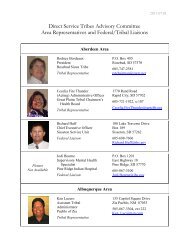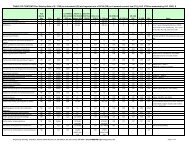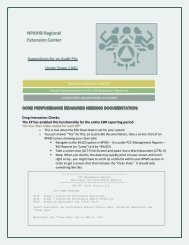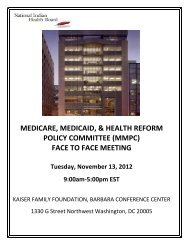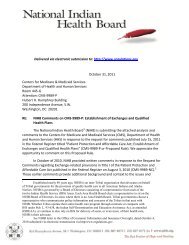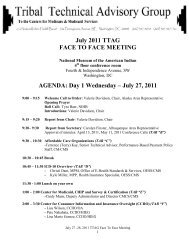âHealth Insurance Premium Tax Creditâ (IRS REG-131491-10)
âHealth Insurance Premium Tax Creditâ (IRS REG-131491-10)
âHealth Insurance Premium Tax Creditâ (IRS REG-131491-10)
- No tags were found...
Create successful ePaper yourself
Turn your PDF publications into a flip-book with our unique Google optimized e-Paper software.
NIHB Supplemental Submission - Definition of IndianJudicial deference is even required when the court disagrees with the agency‘sinterpretation. 70―[T]he case for deference is particularly strong when the agency has interpretedregulatory terms regarding which it must often apply its expertise.‖ 71 Along with the BIA,IHS and other agencies within HHS have the greatest expertise in determining who is an―Indian‖ for purposes of programs serving Indians. As a result, courts would accord a higherlevel of deference to any reasonable regulatory definition of the term ―Indian‖ that HHSpromulgates.This deference is illustrated in Alaska Chapter, Associated General Contractors v.Pierce, 72 where the court gave substantial deference to another agency‘s definition of Indianeven though it was alleged to go beyond the ISDEAA definition. In Pierce, the plaintiffchallenged a regulation promulgated by the Department of Housing and Urban Development(―HUD‖) that defined ―Indian‖ for the purposes of the ISDEAA‘s Indian hiring preferencerequirement. 73 HUD interpreted the ISDEAA definition to include ―any person recognizedas being an Indian or Alaskan Native by a Tribe, the Government, or any state,‖ with a―tribe‖ then defined as ―an Indian tribe, band, pueblo, group or community of Indians orAlaskan Natives.‖ 74 The court upheld the regulatory definition because it was ―rationallyrelated to the fulfillment of Congress‘ unique obligation toward Indians and AlaskaNatives.‖ 75A court would give a reasonable definition of ―Indian‖ adopted by HHS or anotherFederal agency to implement the ACA at least as much deference as the court in Pierce. Thisis also a clear example of the fact that HHS has the inherent authority to promulgate such aregulation in the first instance.5.3 Statutory Ambiguity Should Be Resolved by Regulations.5.3.1 References to More Than One Statute Has Created Ambiguity forThose Charged with Implementing ACA.70See, e.g., Am. Radio Relay League, Inc. v. F.C.C., 617 F.2d 875, 881 (D.C. Cir. 1980) (―Hadwe been the rulemakers in this case, we might have been more hesitant in encroaching on the domainof the innocent amateur operators. Nonetheless, we cannot say that the agency abused its discretion inadopting the rules that it did.‖).71Wash. Urban League v. F.E.R.C., 886 F.2d 1381, 1386 (3rd Cir. 1989) (citations omitted.Accord MCI Telecommunications Corp. v. F.C.C., 822 F.2d 80, 84-85 (D.C.Cir. 1987); W. Union Tel.Co. v. FCC, 541 F.2d 346, 351 (3rd Cir.1976).7273694 F.2d 1162 (9th Cir. 1982).See 42 U.S.C. § 450e(b)(i) (requiring that ―preferences and opportunities for training andemployment in connection with the administration of such contracts or grants shall be given toIndians‖).747524 C.F.R. § 805.<strong>10</strong>2.Alaska Chapter, 694 F.2d at 1170.National Indian Health Board Page 17 of 24 October 31, 2011




